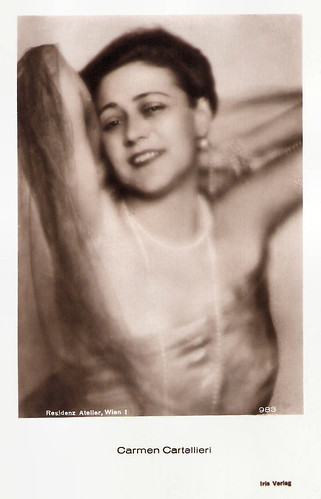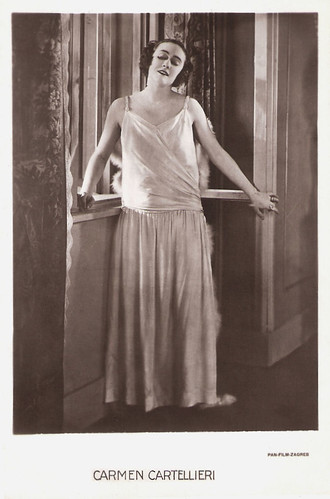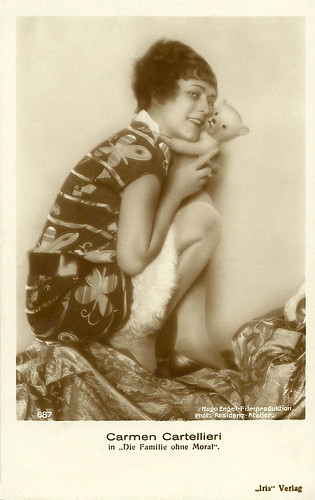
Austrian postcard by Iris Verlag, no. 315. Photo: Residenz-Atelier, Vienna.

Croatian (former Kingdom of Yugoslavia) postcard by Jos. Caklovic, Zagreb, no. 23. Photo: Pan-Film, Zagreb. Charlotte Ander, Claude France and Carmen Cartellieri.
Kill her!
Carmen Cartellieri was born Franziska Ottilia Cartellieri in Prossnitz, Austria-Hungary (now Prostejov, Czech Republic) in 1891. She was the daughter of an engineer and grew up in Innsbruck and other places.
At the age of 16, she got married to the chemist, painter, inventor and for a while film director Mano Ziffer-Teschenbruk, and in the early 1910s, their daughter was born. Carmen stayed a hausfrau till 1918 when Tyrolean director and scriptwriter Cornelius Hintner discovered her by accident. He offered her a part in the Hungarian film Az összeesküvök/The Conspirators (Emil Justitz, 1919), for which he had written the script.
After her six more Hungarian films under the stage name Carmen Teschen, the political situation caused her to move from Budapest to Vienna. There she appeared in Hintner's Anjula, das Zigeunermädchen/Anjula, the Gypsy Girl (Cornelius Hintner, 1919) and Die Würghand/The Strangling Hand (Cornelius Hintner, 1920). The Viennese public liked her and she was chosen as 'the most beautiful actress of Vienna'. Next, she starred in Carmen lernt Schifahren/Carmen Learns To Ski (Mano Ziffer-Teschenbruk, 1920), directed by her husband and produced by her own newly established film company.
For Cartellieri-Film, the actress subsequently played in Der weisse Tod/The White Death (1921), Das Drama in den Dolomiten/The Tragedy in the Dolomites (Cornelius Hintner, 1921), Parema - Das Wesen aus der Sternenwelt/Parema, Creature from the Starworld (Mano Ziffer-Teschenbruk, 1922), Die gelbe Gefahr/The Yellow Danger (1922), and Die Sünde der Inge Lars/The Sin of Inge Lars (Mano Ziffer-Teschenbruk, 1922). In the meantime she also played in one German film shot in Berlin, Büsse der Leidenschaft (Paul von Woringen, 1920), as well as in the Austrian production Der tote Hochzeitsgast/The Dead Wedding Guest (1921) by Max Neufeld, a film director with whom she would frequently collaborate.
After Cartellieri-Film stopped, Cartellieri continued to work at other minor Austrian companies: Töte sie!/Kill Her! (Cornelius Hintner, 1922), Die Sportlady/The Sporting Lady (Cornelius Hintner, 1922), Die Menschen nennen es Liebe/People Call It Love (Mano Ziffer-Teschenbruk, 1922) with Fred Louis Lerch, Die Frauen des Harry Bricourt/The Wives of Harry Bricourt (Richard Arvay, 1922) starring Anton Tiller, Eines Vaters Söhne/Son of a Father (Paul Garbagni, 1923) with Olaf Fjord, Fiat Lux (Wilhelm Thiele, 1923) opposite Hella Moja, Was ist Liebe...?/What is Love...? (Leopold Niernberger, 1924), Die Geheimnis der Schrift/The secret of the Writing (Dezsö Kertész, 1924) with Erika Glässner, and Die Tragödie einer Frau/The Tragedy of a Woman (Dezsö Kertész, 1924) with Max Landa.

Austrian postcard by Iris Verlag, no. 989. Photo: Residenz Atelier, Wien.

Yugoslavian postcard by Jos. Caklovic, Zagreb, no. 26. Photo: Pan-Film, Zagreb.
The hands of Orlac
In 1924 Carmen Cartellieri played in the expresionistic horror classic Orlacs Hande/The Hands of Orlac by reputed director Robert Wiene. Conrad Veidt is featured as a famous pianist whose hands have been replaced by those of a murderer.
The Austrian-German co-production was shot in Vienna, but for Cartellieri it did not result in a one-way ticket to Babelsberg. She basically remained in Vienna to act in Austrian films, until the end of the silent era.
Sometimes she worked with renowned directors such as Max Neufeld in Der Balletherzog (1926) co-starring Werner Pittschau, and again with Wiene in Der Rosenkavalier/The Knight Of The Rose (1925), based on the opera by Richard Strauss and written by Hugo von Hofmannsthal, the opera's librettist. During the 1920s she also worked in the theatre. She often appeared at the Ronacher theatre in Vienna, but she was also seen in the 1926 Pantomime Der Todesring (The Ring of Death).
Cartellieri acted in a handful of films in Munich for the Emelka company, such as Die Hölle von Montmartre/The Hell of Montmartre (Willy Reiber, Frans Seitz, 1927), where she played opposite Suzy Vernon, and she made one more film in Berlin, Madame wagt einen Seitensprung/Madame Ventures an Affair (Hans Otto Löwenstein, 1927) with Xenia Desni.
Then the era of the silent cinema was over and so was Cartellieri's film career. But she retired with a bang, while her ler last appearance was a plum role in the Mayerling drama Das Schicksal derer von Habsburg/The Destiny of the Von Habsburgs (1928). Little is known about her later life. Carmen Cartellieri died in Vienna in 1953.

Austrian postcard by Iris Verlag, no. 687. Photo: Residenz-Atelier / Hugo Engel-Filmproduktion. Publicity still for Die Familie ohne Moral/The family without morals (Max Neufeld, 1927). Collection: Didier Hanson.
DVD trailer of Orlacs Hände/The Hands of Orlac (Robert Wiene, 1924). Source: Kino International (YouTube).
Sources: Thomas Staedeli (Cyranos), Wikipedia (German), and IMDb.
This post was last updated on 9 September 2023.
What an interesting post! The clip at the end about the hands was terrific. Half scared me.
ReplyDelete